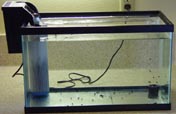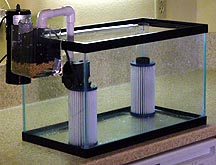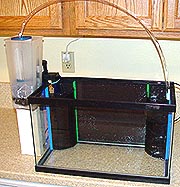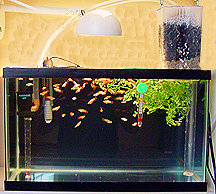

TESTING
A 75-GALLON-PER-HOUR, FRY-SAFE FILTER
A
design for a high-volume filter that's safe to use with fry.
(Click on Bettas to return to the main betta page or on main site to browse 70 topics ranging from exotic kaleidoscope designs to the strange world of lucid dreaming.)
We
all have our talents: Bach could write music, Einstein could do
math, and I cause disease in fry tanks.
My second spawn was a great learning experience for dealing with diseases but a disaster as far as effective prevention was concerned. For my third spawn I'm determined to do better... a lot better.
Cleanliness seems to be my biggest problem. In spite of regular vacuuming, cutting back on food and regular water changes, my fry tank always gets cloudy. To help keep the tank crystal-clear and disease-free for the third spawn, I designed a new type of high-capacity filter that's fry safe.
The design starts with a Aqua-Tech 5-15 filter, rated at 100 gallons per hour. I surrounded the intake line, which pulls in water far too fast for any fry and many adult bettas to resist, with a 9-inch long by 3-inch diameter, pleated drum filter cartridge. This cuts the flow to 75 gallons per hour, distributes it over such a large area that the average intake velocity is reduced to safe levels even for newly-hatched fry, and provides excellent mechanical filtration. In addition to the filter/carbon insert that fits inside the Aqua-Tech's body, I filled the entire volume of the body with activated carbon. This greatly increases the amount of fine-particulate and chemical filtering. Lastly, instead of letting the exhaust water waterfall out into the tank where it could create dangerous currents, I ducted it across the tank and had it empty into a tank-high tube, 2-inches in diameter with small holes drilled in it so that the current was distributed over a large enough area to be safe for fry. The value of ducting the water across the tank is that it greatly increases the circulation efficiency of the filter.
Here's what it looks like:

Regrettably, the cross-tank duct and exhaust tube are transparent and difficult to see.
Even though the through-put is 75-gallons per hour, incredible for a fry tank, the currents are mild enough so that even inactive, newly-hatched fry are safe from being swept up. I'm currently testing this filter on the fry from the second spawn and everything seems to be working perfectly.
Introducing the Microbe-Killer 2000! The prototype pictured above worked nice but I decided I wanted something better. I started with switching to a Magnum micron filter to trap smaller particles than the lower-grade filters used in the prototype. Also, I noticed that the holes in the water-return tube created jets that could injure a fry that managed to get close to them so I relaced the holed tube with a second filter cylindar. This also provided a second filtration stage. The biggest change was adding a 4 watt Angstrom 2537 brand ultraviolet sterilizer after the carbon filter assembly. The small inlet hole on the UV sterilizer reduced the flow to 49 gallons per hour, but this is still incredably high for a fry tank. The Aqua-Tech filter has been relpaced with a small powerhead pump. Here's what the completed filter looks like:

I call it the Microbe Killer 2000. Why 2000? No real reason, it just sounded good.
I'm currently using my third spawn to test it. If the cross-tank flow really is low enough and smooth enough to avoid disturbing the spawn and fry this could be a valuable addition to betta spawners everywhere.
IT WORKS!!! I used the Microbe Killer 2000 on the forth spawn and it worked perfectly! The cross-tank flow is so gentle and smooth that it's impossible to detect the slightest ripple on the water's surface. This is essential for protecting the bubblenest. More importantly, when the female released her eggs they fell straight down and weren't swept away by a current. The male had no problem collecting them. When the fry hatched, they too fell without being drawn anywhere near the intake of the filter. And remember, this unit is pumping 49 gallons per hour in a 10-gallon tank. The water is staying absolutely crystal clear. Particles of waste fall to the bottom of the tank and require siphoning, but I do this every day anyway. The important thing is that the water stays clear and clean. Now it'll be interesting to see if the UV sterilizer helps prevent fry diseases.
NEWER!!! Filter update! As nice as the Micro Killer 2000 was, it had several problems. There was a lot of hardware in the tank, which gave too many places for fry to hide and a lot of surface area for algae to grow. Also, it was difficult to clean everything without disturbing the fry. Siphoning the bottom of the tank was almost impossible. The outside canister was very limited as to how much carbon it could hold. But, the biggest problem was that the intake filter cartridge capture debris on the outside surface; when the cartridge was taken out of the tank for cleaning much of that debris fell off back into the tank. The solution to all these shortcomings?... the Microbe Killer 3000!

Starting on the right, the same pump used in the earlier version pulls water through a very fine black mesh, which prevents fry from being sucked up. The mesh is black sheer material attached to a plastic screen held in place by two plastic binder sleeves glued to the sides of the tank. (Black was used to darken the background so that the fry can be seen easier.) The water is pumped up the clear plastic tube, over to the left side of the tank where it empties into a Magnum micron filter. From there it drains into a two-pound bed of small-grain activated carbon (I follow the activated-carbon philosophy that more is better.), then through six ounces of nitrogen absorbing crystals, and then through a 4-watt ultraviolet sterilizer. The filter, carbon, and nitrogen absorbing crystals are contained in a plastic spaghetti cannister glued to the side of the sterilizer. The output from the sterilizer dumps into the tank through a cloth sleeve (to prevent gurgling), and into another zone protected by a screen barrier. The throughput was measured at 75 gallons per hour. Even at this high flow rate, the tank is completely ripple-free and the current is so slow and gentle that fry as young as three days can easily out swim it. A nice feature of the tank itself is that the lower forward edge, the zone that can't be seen from outside the tank, has been filled in with aquarium sealant. This way there is no blind stop for the fry to hide in and vision isn't impaired when siphoning the tank bottom. I'm currently using this system on my fifth spawn and it seems to be working outstanding.
NEW!!! Filter failure? Not quite, but I'm calling the ultra-violet sterilizer part of the filter a waste of time. In spite of its presence, I've still had outbreaks of algae and bacteria. It may have helped a little, but little isn't enough when one considers the expense and the design complications caused by using it.
NEW!!! Final configuration! Here's what my final filter system looks like:

Gone is the ultraviolet sterilizer and all the design complications it caused. The action starts on the left with a Powerhead 201 filter drawing water in through a 6-inch plastic tube drilled with 24 small holes. These holes distribute to water pulled in over a large area so that the suction at any one point isn't great enough to pull in unsuspecting fish. The water is pushed up a tube and over to the right side of the tank where it dumps into a Micron water polishing filter that's been cut in half and had its bottom opening sealed. Gross and fine soil are trapped in this filter, which can be easily removed and rinsed out without disturbing the fish. After passing through the filter, the water percolates down through a six-inch bed of activated carbon and then two inches of ammonia absorbing granules. These quantities represent ten times the amount usually used for a tank this size. From there the water empties back into the tank via a perforated tube. The container for the carbon was made from a spaghetti holder purchased from a dollar store.
To convert this system to one that's safe for fry, all I have to do is slide two cloth-covered plastic meshes into holders glued to the side of the tank (not visible in this picture). The cloth further softens and distributes the suction and return flows so that the fry aren't injured.